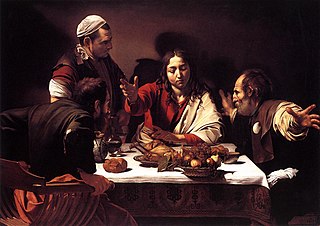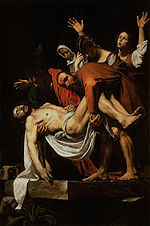
Christology, literally "the understanding of Christ," is the study of the nature (person) and work of Jesus Christ. It studies Jesus Christ's humanity and divinity, and the relation between these two aspects; and the role he plays in salvation.

The Gospel According to Mark is one of the four canonical gospels and one of the three synoptic gospels. It tells of the ministry of Jesus from his baptism by John the Baptist to his death and burial and the discovery of the empty tomb – there is no genealogy of Jesus or birth narrative, nor, in the original ending at chapter 16, any post-resurrection appearances of Jesus. It portrays Jesus as a heroic man of action, an exorcist, a healer, and a miracle worker. Jesus is also the Son of God, but he keeps his identity secret, concealing it in parables so that even most of the disciples fail to understand. All this is in keeping with prophecy, which foretold the fate of the messiah as suffering servant. The gospel ends, in its original version, with the discovery of the empty tomb, a promise to meet again in Galilee, and an unheeded instruction to spread the good news of the resurrection.

The Gospel of John is the fourth of the canonical gospels. The work is anonymous, although it identifies an unnamed "disciple whom Jesus loved" as the source of its traditions. It is closely related in style and content to the three Johannine epistles, and most scholars treat the four books, along with the Book of Revelation, as a single corpus of Johannine literature, albeit not from the same author.

In Christianity, the empty tomb is the tomb of Jesus that was found to be empty by the women myrrhbearers who had come to his tomb to carry out their last devotions to Jesus' body by anointing his body with spices and by pouring oils over it. All four canonical gospels report the incident with some variations.
The historicity of Jesus is the question if Jesus of Nazareth can be regarded as a historical figure. Virtually all New Testament scholars and Near East historians, applying the standard criteria of historical-critical investigation, find that the historicity of Jesus is effectively certain, although they differ about the beliefs and teachings of Jesus as well as the accuracy of the details of his life that have been described in the gospels.

The Signs Gospel or the semeia source is a hypothetical gospel account of the life of Jesus Christ which some scholars have suggested could have been a primary source document for the Gospel of John. This theory has its basis in source criticism. Since the commentary of Rudolf Bultmann was published in 1941, the hypothesis of a semeia source has gained some acceptance.

Géza Vermes, was a British academic, Bible scholar, and Judaist of Hungarian Jewish origin—one who also served as a Catholic priest in his youth—and writer on history of religion, particularly Judaism and early Christianity. He wrote about the Dead Sea Scrolls and ancient works in Aramaic such as the Targumim, and on the life and religion of Jesus. He was one of the most important voices in contemporary Jesus research, and he has been described as the greatest Jesus scholar of his time. Vermes' written work on Jesus focuses principally on Jesus the Jew, as seen in the broader context of the narrative scope of Jewish history and theology, while questioning and challenging the basis of the Christian doctrine on Jesus.

The swoon hypothesis is any of a number of ideas that aim to explain the resurrection of Jesus, proposing that Jesus did not die on the cross, but merely fell unconscious ("swooned"), and was later revived in the tomb in the same mortal body. This 200-year-old hypothesis is still the subject of debate to this day.

The stolen body hypothesis posits that the body of Jesus Christ was stolen from his burial place. His tomb was found empty not because he was resurrected, but because the body had been hidden somewhere else by the apostles or unknown persons. Both the stolen body hypothesis and the debate over it presume the basic historicity of the gospel accounts of the tomb discovery. The stolen body hypothesis finds the idea that the body was not in the tomb plausible - such a claim could be checked if early Christians made it - but considers it more likely that early Christians had been misled into believing the resurrection by the theft of Jesus's body.

The post-resurrection appearances of Jesus are the earthly appearances of Jesus to his followers after his death and burial. Believers point to them as proof of his resurrection and identity as Messiah, seated in heaven on the right hand of God.
The Census of Quirinius was a census of Judea taken by Publius Sulpicius Quirinius, Roman governor of Syria, upon the imposition of direct Roman rule in 6 CE. The Gospel of Luke uses it as the narrative means to establish the birth of Jesus, but places it within the reign of Herod the Great, who died 9 years earlier. No satisfactory explanation of the contradiction seems possible on the basis of present knowledge, and most scholars think that the author of the gospel made a mistake.
Lewis's trilemma is an apologetic argument traditionally used to argue for the divinity of Jesus by arguing that the only alternatives were that he was evil or deluded. One version was popularised by University of Oxford literary scholar and writer C. S. Lewis in a BBC radio talk and in his writings. It is sometimes described as the "Lunatic, Liar, or Lord", or "Mad, Bad, or God" argument. It takes the form of a trilemma — a choice among three options, each of which is in some way difficult to accept.

1 Corinthians 15 is the fifteenth chapter of the First Epistle to the Corinthians in the New Testament of Christian Bible. It is authored by Paul the Apostle and Sosthenes in Ephesus. The first eleven verses contain the earliest account of the post-resurrection appearances of Jesus in the New Testament. The rest of the chapter stresses the primacy of the resurrection for Christianity. Readings from the text are used at funerals in the Catholic Church, where mourners are assured of the "sure and certain expectation of the resurrection to a better life".
The historical reliability of the Gospels refers to the reliability and historic character of the four New Testament gospels as historical documents. Some believe that all four canonical gospels meet the five criteria for historical reliability; and others say that little in the gospels is considered to be historically reliable. Almost all scholars of antiquity agree that Jesus existed, but scholars differ on the historicity of specific episodes described in the Biblical accounts of Jesus, and the only two events subject to "almost universal assent" are that Jesus was baptized by John the Baptist and was crucified by the order of the Roman Prefect Pontius Pilate. Elements whose historical authenticity is disputed include the two accounts of the Nativity of Jesus, the miraculous events including the resurrection, and certain details about the crucifixion.
The new creation is a concept found in the New Testament, related to the new life and new man but with reference also to the Genesis "old creation."

The historicity and origin of the resurrection of Jesus has been the subject of historical research and debate, as well as a topic of discussion among theologians. The accounts of the Gospels, including the empty tomb and the appearances of the risen Jesus to his followers, have been interpreted and analyzed in diverse ways, and have been seen variously as historical accounts of a literal event, as accurate accounts of visionary experiences, as non-literal eschatological parables, and as fabrications of early Christian writers, among various other interpretations. It has been suggested, for example, that Jesus did not die on the cross, that the empty tomb was the result of Jesus' body having been stolen, or, as was common with Roman crucifixions, that Jesus was never entombed.
Christian Beginnings from Nazareth to Nicea, AD 30-325 is a 2012 book by the historian Geza Vermes, Professor of Jewish Studies at the University of Oxford, which traces the development of the figure of Jesus from charismatic Jewish prophet to being considered equal with God by the fourth century Council of Nicea. It follows his earlier works on Jesus the Jew.















